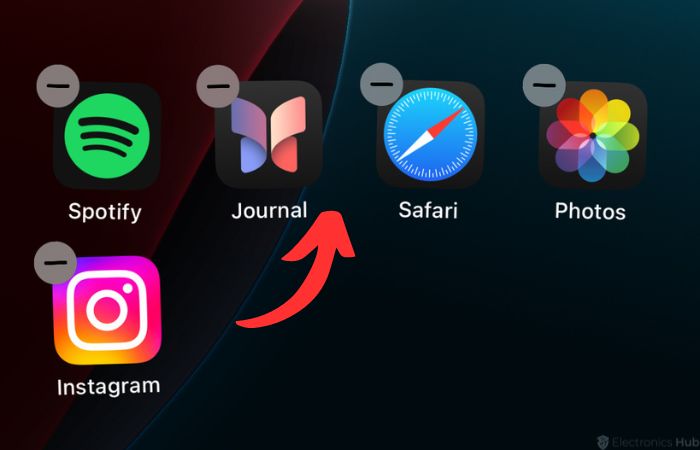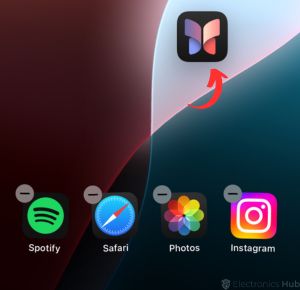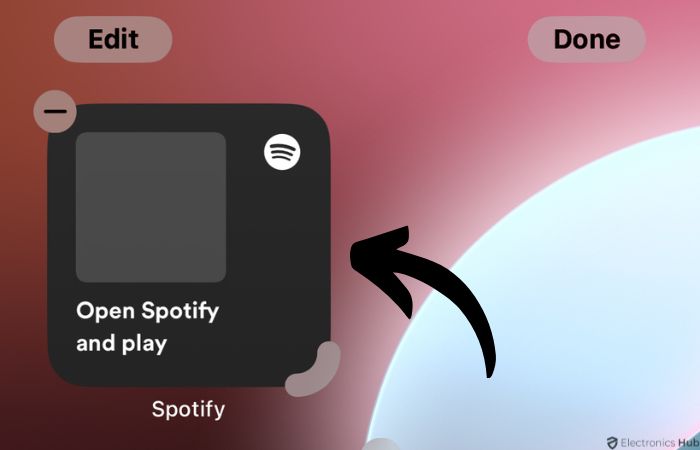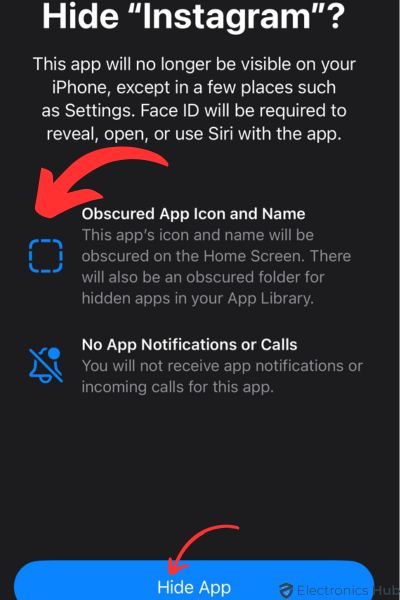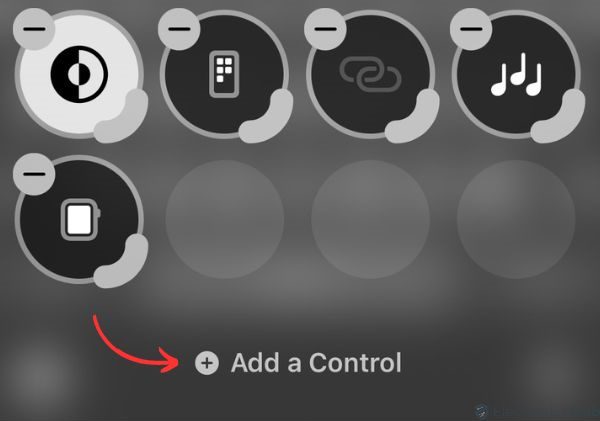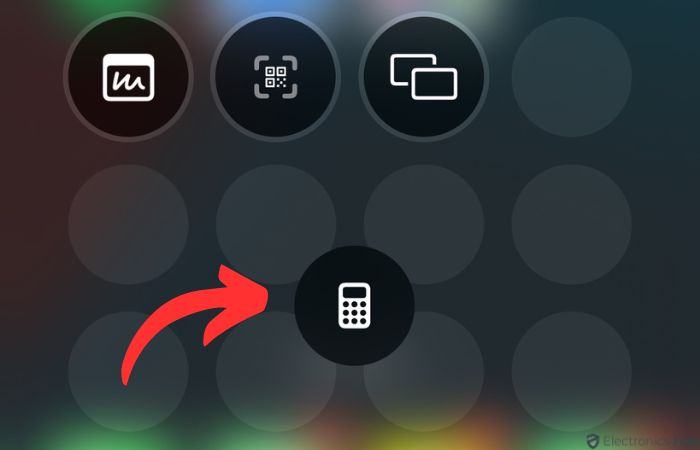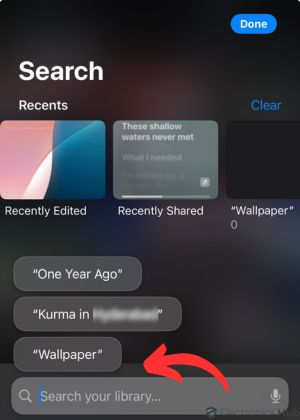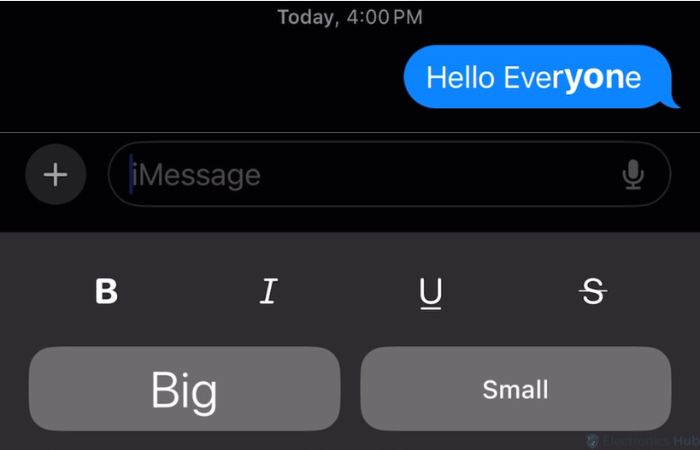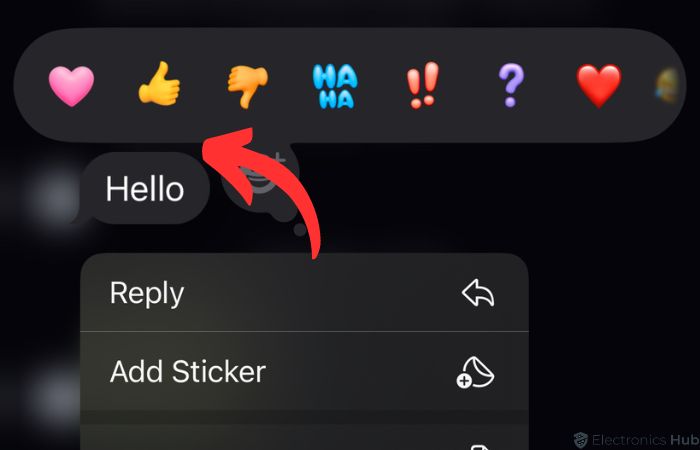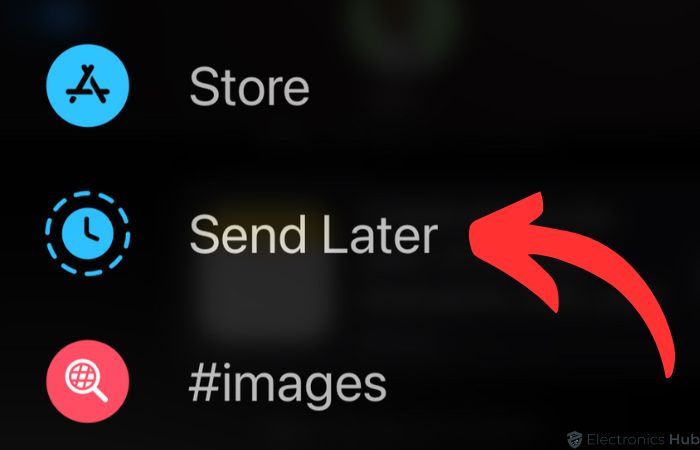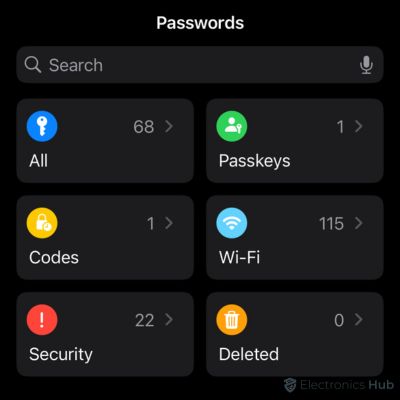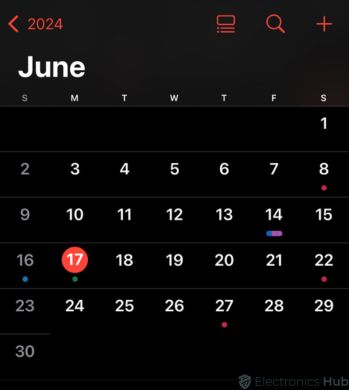Apple’s annual WWDC event has wrapped, and with it came the exciting reveal of iOS 18. This new update promises to bring a wave of fresh features and improvements to your iPhone experience. But how does it stack up against its predecessor, iOS 17?
In this blog post, we’ll explore the changes announced at WWDC. We will look at the main differences between iOS 18 and iOS 17. We’ll check out what’s new and improved. This will help you decide if you should upgrade your iPhone. Get ready to see features like better personalization options, a new control center, and new accessibility features. These are all designed to make your iPhone even smarter.
Outline
Toggle- Features Comparison: iOS 18 vs iOS 17
- Features Released In iOS 18
- # Video Tutorial – For Latest Features in iOS 18
- 1. AI and Personal Assistance
- 2. Customization
- 3. Photos In iOS 18: Transforming Memory Organization
- 4. Messages In iOS 18: Elevating Everyday Communication
- 5. Safari in iOS 18: Smarter, Intuitive Browsing
- 6. Passwords App in iOS 18: Centralized Security Access
- 7. Accessibility in iOS 18: Pioneering Inclusivity
- 8. Maps in iOS 18: Precision and Personalized Navigation
- 9. Game Mode in iOS 18: Boosting Gamer Performance
- 10. Wallet in iOS 18: Streamlined Transactions, Better Event Experiences
- 11. AirPods in iOS 18: Boosted Interactivity & Personalized Audio
- 12. Notes in iOS 18: Elevating Productivity and Collaboration
- 13. Journal in iOS 18: Cultivating Mindfulness and Organization
- 14. Home App in iOS 18: Enhanced Audio Features
- 15. Privacy and Security in iOS 18: Enhanced Control and Protection
- 16. Enhancements in More Apps in iOS 18
- 17. New Features Added in iOS 18
- iOS 18 vs iOS 17: Comprehensive Comparison and Analysis
- How To Install iOS 18 Beta?
- FAQs:
- Conclusion
Features Comparison: iOS 18 vs iOS 17
|
Feature Category |
iOS 18 Enhancements |
iOS 17 Features |
|
AI(Apple Intelligence) and Personal Assistance |
ChatGPT integration, smarter Siri with enhanced context awareness |
Basic Siri functionalities, limited context understanding |
|
Customization |
Flexible app/widget arrangement, new icon designs, enhanced Control Center |
Static grid layout for apps, basic Control Center |
|
Security |
App locking/hiding, advanced data protection, encryption standards |
Not Accessible of encryption |
|
Communication |
RCS messaging, satellite messages, customizable Tapbacks, “Send Later” feature |
Basic messaging, standard SMS, limited Tapbacks |
|
Media Management |
Smart Collections, dynamic Carousel, personalized spatial audio for gaming |
Manual photo sorting, basic spatial audio |
|
Navigation |
Topographic maps, offline access, custom routes for hikers and walkers |
Basic navigation features, no offline access |
|
Accessibility |
Eye Tracking, Music Haptics, customizable Vocal Shortcuts |
Standard accessibility features without advanced customization |
|
Home and Smart Living |
Guest access customization, hands-free unlocking, robot vacuum integration |
Basic smart home controls, limited third-party integration |
|
Health and Safety |
Emergency SOS live video, enhanced Apple Fitness+ |
Basic health tracking, no live video SOS |
Features Released In iOS 18
# Video Tutorial – For Latest Features in iOS 18
1. AI and Personal Assistance
- iOS 17: Basic Siri capabilities with limited understanding of context.
- iOS 18: Advanced Siri enhancements, offering richer language processing and greater contextual understanding.
A Snapshot:
- ChatGPT Integration: Unique to iOS 18, enabling broader functionalities like content creation and real-time assistance.
- Interactive Experience: iOS 18’s AI is interactive, making devices more responsive to user habits and requests.
- Enhanced Siri: Siri in iOS 18 understands context better and handles complex requests more efficiently.
- Practical Uses: Improved AI can handle more complex tasks such as scheduling, reminders, and email drafting.
Quick Comparison
|
Feature |
iOS 17 |
iOS 18 |
|
Siri Intelligence |
Basic context understanding |
Enhanced contextual awareness |
|
AI Integration |
None |
ChatGPT integration |
|
Proactive Assistance |
Limited |
Improved across devices |
|
Continuity |
Device-specific |
Seamless multi-device interaction |
|
Language Support |
Limited |
Expanded language and dialect support |
|
Key Takeaway: iOS 18 revolutionizes personal assistance with smarter Siri and ChatGPT integration, making your device more intuitive and capable than ever before. |
Genmoji: Personalized Creativity
- iOS 17: Featured basic capabilities for creating and managing images and memory movies, with tools like Memoji and Animoji that offered fun, yet limited, personalization.
- iOS 18: Enhances personal media experiences significantly with Genmoji and improved Memory movies, using advanced AI to provide a highly customized and interactive user experience.
What Is Genmoji?
A new feature in iOS 18, Genmoji allows users to create dynamic, responsive images that adapt based on user interactions, offering a more advanced level of personalization than iOS 17’s Memoji and Animoji.
- Enhanced Memory Movies: Leveraging machine learning, iOS 18’s Photos app now curates personalized memory movies that stitch together favorite moments into thematic presentations, providing a richer and more meaningful viewing experience.
- Interactive Editing Tools: iOS 18 introduces more sophisticated editing tools that allow users to customize their photos and videos with greater precision and creativity.
- AI-Driven Content Suggestions: The system suggests themes and enhancements based on the content of images and videos, making creative decisions easier and more impactful.
- Shared Experiences: Enhanced sharing options in iOS 18 enable users to collaboratively edit and share memory movies and Genmoji creations with friends and family, enhancing social connectivity.
Quick Comparison
|
Feature |
iOS 17 |
iOS 18 |
|
Personalized Avatars |
Memoji and Animoji |
Genmoji with dynamic, responsive customization |
|
Memory Movies |
Basic automated compilations |
AI-curated thematic memory movies with advanced editing |
|
Editing Tools |
Standard photo/video editing |
Advanced interactive editing tools |
|
Content Suggestion |
Limited AI suggestions |
Enhanced AI-driven suggestions for creative content |
|
Collaborative Features |
Minimal collaborative options |
Collaborative editing and sharing of creative content |
|
Key Takeaway: Experience deep personalization that makes your iPhone uniquely yours with Gnmoji. And with Enhanced Memory Movies, one can interact more with photos and videos for a richer and more engaging experience. |
2. Customization
- iOS 17: Limited to static grid layouts for apps and widgets, offering basic customization that constrained user creativity and personalization.
- iOS 18: Introduces unprecedented flexibility in organizing apps and widgets, including customizable sizes and positions, allowing for a truly personalized interface.
A Snapshot:
- Icon Design Enhancements: iOS 18 brings new icon designs, including options for shape, color, and thematic styling that automatically adjusts to match the wallpaper, enhancing aesthetic consistency across the device.
- Control Center Customization: The redesigned Control Center in iOS 18 allows users to include additional controls, organize them according to preference, and access them more intuitively with redesigned interaction flows.
- Home Screen Dynamics: Beyond static icons, iOS 18 allows for widgets that integrate live data and animations, transforming the Home Screen into an active, responsive workspace.
Quick Comparison
|
Feature |
iOS 17 |
iOS 18 |
|
Home Screen Layout |
Static grid of icons and widgets |
Flexible arrangement with resizable icons and widgets |
|
Icon Customization |
Limited to rearranging icons |
Advanced customization including style, color, and dynamic themes |
|
Widget Functionality |
Basic widgets with limited interactivity |
Interactive and dynamic widgets with live data |
|
Control Center Access |
Multiple steps to customize |
Streamlined, single-step customization |
|
Visual Themes |
Basic light and dark mode |
Comprehensive theming with context-aware adjustments |
|
Key Takeaway: iOS 18 significantly enhances the customization capabilities of the iPhone, empowering users to tailor their devices more deeply than ever before. This level of personalization not only improves aesthetic appeal but also functionality, making the user interface more engaging and aligned with individual preferences. |
A Comprehensive Overview:
a. App Management
In iOS 18, Apple has upgraded the way users can organize app icons on the Home Screen. Now, individuals can place icons in more diverse spots, but they must still align them within one of the four designated grid areas.
The updated system supports more personalized layouts, allowing for empty spaces without needing blank widgets. These enhancements give users better control and customization over their device’s interface, simplifying app organization while keeping a structured grid system.
Here’s How You Rearrange Apps:
- Access the Home Screen: Unlock your iPhone. Go to the Home screen to arrange your apps.
- Enter Edit Mode: Press and hold any app icon until all icons start shaking. This means you are in edit mode.
- Select an App Icon: Tap and hold the app you want to move. It will enlarge to indicate it’s ready to be moved.
- Move the Icon: Drag the app to your desired location. iOS 18 allows for new positioning options.
- Position in the Grid: While you have flexibility in vertical positioning, icons must still align with one of the grid’s four slots.
- Create Empty Spaces: You can leave spaces above other icons. This helps create a cleaner, more personalized layout.
- Exit Edit Mode: Tap “Done” in the top right or press the home button to save your layout and exit edit mode.
b. Resizing Widgets
iOS 18 brings an enhanced, intuitive widget customization feature to the iPhone. Users can now resize widgets directly on the home screen. They no longer need to delete and re-add them.
A new resizing tool, marked by a grabber in the bottom right corner of the widget, facilitates dynamic adjustments. This new feature allows users to change the shape and size of widgets, either expanding them into a rectangle or shrinking them to a square. There’s also an option to convert a widget into a standard app icon.
How to Resize Widgets:
Step 1: Enter Jiggle Mode
- Press and hold an empty spot on your home screen until the icons start to jiggle.
Step 2: Locate the Widget Resizer
- Look for a small grabber icon at the bottom right-hand corner of the widget.
Step 3: Resize the Widget
- Rectangle: Drag the grabber outwards to form a rectangle.
- Square: Pull the grabber inward to create a square.
Step 4: Convert a Widget into an App Icon
- Press “Done” to exit Jiggle Mode.
- Press and hold the desired widget, then select “Edit Widgets” to convert it into an app icon.
Step 5: Additional Widget to App Icon Conversion
- Once converted, the widget appears as an app icon on the home screen.
- To expand it back into a widget, tap and drag the app icon.
c. A New Era of Icon Aesthetics
The new iOS 18 update greatly improves the Home Screen’s app icons, offering more ways to customize them compared to iOS 17. Now, you can choose from new styles for app icons, like dark or tinted.
You have the option to set your app icons to light or dark mode, or they can change automatically with the system-wide Dark Mode settings. This is a change from iOS 17, where the app icons didn’t change appearance and had no options for Dark Mode or different colors.
How To Change App Icon Color:
- Long Press on the Home Screen: Start by pressing and holding on your iPhone’s home screen until the icons start to shake. This shows you’re in edit mode.
- Tap ‘Edit’: With iOS 18, you’ll see an ‘Edit’ option at the top of the screen. Tap this to move forward.
- View Customization Options: After tapping ‘Edit’, you’ll see ‘Add Widget’ and ‘Customize’, each with a new icon.
- Choose ‘Customize’: Tap on ‘Customize’ to open the menu for changing app icon appearances.
- Select Mode: In the menu, you have several choices:
- Light Mode: Returns icons to their standard look.
- Tinted Mode: Lets you alter the icon colors to suit your style or wallpaper.
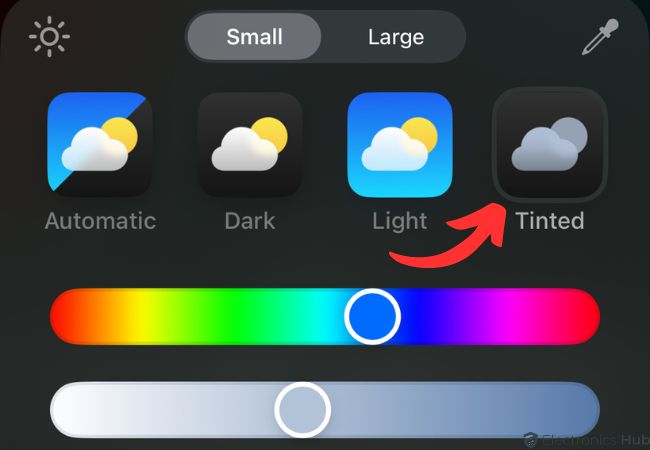
-
- Color Picker: Pick a color and adjust its saturation to get the desired intensity.
- Darken Wallpaper: Tap the sun icon in the top left to darken your wallpaper for better icon visibility.
- Adjust Icon Size: Choose ‘Large’ to make the icons bigger and remove text labels for a cleaner interface.
- Automatic Mode: Select ‘Automatic’ to let the system change the icon theme based on your settings, like light or dark mode.
- Apply Changes: Press the home button or swipe up to exit edit mode and apply your settings.
- Make Adjustments: If you’re not happy with the look or find glitches, you can go back to customize further until it’s right.
d. Swapping of Lock Screen Controls
With this feature, iOS 18 lets users customize their Lock Screen by adding shortcuts to any app. With this update, you can replace the default flashlight and camera shortcuts with your preferred apps.
How To Add App On Home screen:
- Wake up your iPhone and swipe to view the lock screen.
- Find the lock screen buttons. They may have moved for new customization features.
- Tap the ‘+’ (plus) sign on the lock screen. This brings up a menu similar to the Control Center, tailored for lock screen adjustments.
- Scroll through the menu to see various options you can add to your lock screen, including utilities and quick access shortcuts.
- Choose the “Open App Shortcut” option. This lets you place a direct shortcut to an app on the lock screen. This shortcut is unique to the lock screen and isn’t listed in the Shortcuts app.
- After selecting “Open App Shortcut,” you might experience some delays, as this is a newer feature. Add the shortcut, then revisit this setting for further adjustments if needed.
- Select the app you want to open from the lock screen. For example, if you want quick access to an app named ‘X’, choose it from the list.
- Tap ‘Done’ to save your settings.
- Return to the lock screen to view your new shortcut. You should see options like ‘X’ or ‘Messages’ that you can open directly.
- To verify, press and hold the app shortcut on the lock screen. The app should launch immediately, confirming the shortcut works.
e. Enhanced Security with Locked and Hidden Apps
In iOS 18, Apple has enhanced app privacy by introducing the option to lock and hide applications using Face ID. Users can now set apps to require Face ID for access and to be completely invisible on the home screen.
When activated, the app icon and name disappear, and it stops showing notifications or calls until unlocked with Face ID. These hidden apps are stored in a special folder in the App Library, accessible only after Face ID verification.
Here are the steps to follow to enable this feature:
Step 1: Access Face ID Settings for Specific Apps
- Locate the App: Find the app you want to lock on your home screen. Take Instagram as an example.
- App Settings: Press and hold the Instagram icon until a menu pops up.
- Require Face Face ID: Tap the “Require Face ID” option in the menu to enable Face ID for app access.
Step 2: Enabling Hiding and Locking Features
- Hide and Require Face ID: Select “Hide and Require Face ID” from the settings menu.
- Authenticate: Verify your identity by looking at your device to use Face ID.
- Confirmation Prompt: A prompt will confirm the app icon and name are now hidden. You will see no visible app icon, nor receive notifications or calls from it unless unlocked with Face ID.
Step 3: Confirm App Disappearance from Home Screen
- Check Home Screen: Ensure the app icon is not visible on the home screen after setting it to “Hide and Require Face ID.”
- App Ceases to Exist: The app will remain inaccessible and invisible on your device without further action.
Step 4: Accessing Hidden Apps
- Navigate to App Library: Swipe to reach the App Library, typically found by swiping left on the last home screen page.
- Find Hidden Folder: Look for a new folder labeled “Hidden” in the bottom right corner of the App Library.
- Access Hidden Folder: Tap on the “Hidden” folder.
- Authenticate Face ID: Use Face ID to open the folder.
- View Hidden Apps: All hidden and locked apps are available inside this folder.
f. Control Center
iOS 18 brings a completely redesigned Control Center, a major change from iOS 17. The new layout is broader and features significant enhancements. These improvements focus on boosting user customization and making it easier to use.
1. Adding More Controls
In iOS 18, users can add controls to the Control Center using a new plus icon in the top left corner. This removes the need to go to settings to change controls. Also, iOS 18 lets third-party developers use an API to add their app features to the Control Center. This allows more actions and toggles to be included, enhancing the user experience with more personalized control options available directly from the Control Center.
- Swipe down from the top-right corner of the screen on newer models.
- For older models, swipe up from the bottom of the screen.
- In the top left-hand corner of the Control Center, look for the “+” (plus) icon.
- Tap the “+” icon to see a menu of available control options.
- Browse the list and tap on the control you want to add to your Control Center.
- Continue adding and arranging controls as needed to fit your preferences.
2. Rearrange And Resize Your Control Icon.
In iOS 18, the Control Center allows users to resize many controls and widgets, providing great flexibility. However, volume, brightness, and focus modes remain fixed in size. Users can also adjust the size of app icons and toggles at the bottom of the screen. This customization extends to managing the layout by adding or moving controls to different pages, and setting specific controls as favorites for quick access. Additionally, the update supports multiple pages of icons, offering a more personalized experience. While still in beta and occasionally finicky, these features mark a significant move towards a more customizable interface in iOS environments.
How to Rearrange and Resize Control Icons:
Access Control Center: Swipe down from the top-right corner of your screen.
Resize Widgets:
- Long press on the widget you want to resize to enter “jiggle mode.”
- If resizable, drag the corner to adjust its size.
Non-resizable Widgets: Note that some widgets like volume and brightness can’t be resized.
Rearrange Widgets:
- In jiggle mode, drag widgets to your desired position.
- Move widgets across different pages by swiping left or right.
Add or Remove Widgets:
- To add: Tap the “+” in an empty slot and choose your widget.
- To remove: Tap the “-“ on the widget and confirm.
Favorites Section: To add a widget to Favorites, tap it and select “Add to Favorites.”
Managing Multiple Pages:
- Swipe left or right to navigate through multiple pages.
- Drag a widget to the screen edge to move it to another page.
Adding Controls to Specific Sections: In edit mode, add controls to sections like HomeKit or connectivity.
Quick Navigation in Control Center: In jiggle mode, hold and swipe on the navigation section to quickly move through pages.
3. Photos In iOS 18: Transforming Memory Organization
- iOS 17: Featured manual sorting of photos, which required more user involvement and time to organize memories effectively.
- iOS 18: Enhances the Photos app with smart Collections, dynamic Carousels, and intuitive navigation features, leveraging advanced AI to automate and enrich photo management.
A Snapshot:
- Smart Collections: This feature automatically categorizes photos into thematic groups such as Trips, People, Pets, and Significant Events, using AI to recognize contexts and patterns.
- The Carousel: A new addition in iOS 18, the Carousel dynamically displays a rotating selection of photos from your library, offering a fresh and engaging way to revisit memories without any user input needed.
- Navigating Memories with Ease: Enhanced search and navigation tools in iOS 18 allow users to find specific photos effortlessly by using intuitive prompts and AI-driven suggestions.
- AI-Enhanced Editing Tools: Beyond organization, iOS 18 introduces AI-powered editing tools that suggest enhancements and adjustments to improve photo quality based on the context and content of the photo.
- Shared Memories: This feature enables users to create shared albums that are intelligently suggested based on the attendees of an event or a gathering, enhancing social interactions through shared photographic experiences.
Quick Comparison
|
Feature |
iOS 17 |
iOS 18 |
|
Photo Organization |
Manual sorting and albums |
AI-powered Smart Collections and Carousels |
|
Photo Display |
Static photo streams |
Dynamic Carousel showcasing daily highlights |
|
Search and Navigation |
Basic search functionality |
Advanced AI-driven search and navigation |
|
Editing Tools |
Standard editing features |
Context-aware AI-enhanced editing tools |
|
Shared Albums |
Manual creation and sharing |
AI-suggested shared memories based on events |
|
Key Takeaway: iOS 18 transforms the way users organize and enjoy their photos with AI-driven features that automate organization and enhance the viewing experience. These features not only save time but also create more meaningful interactions with personal memories. |
So what does the Photo app come with in iOS 18?
In iOS 18, the Photos app introduces enhanced editing tools and AI-powered features that improve photo organization and search capabilities. This update also includes more intuitive sharing options, allowing users to seamlessly share their memories across various platforms and devices.
|
Feature |
iOS 18 Enhancements |
|
UI Design |
Single-page interface with improved media viewing. |
|
Editing Tools |
Enhanced editing and AI features; flexible cropping. |
|
Search Bar |
Redesigned for easier access and smarter suggestions. |
|
Organization |
‘Recent Days’ and ‘Trips’ features for auto-organization. |
|
Photo Viewing |
Simplified exit and redesigned icons. |
|
Sharing Options |
Enhanced sharing across devices; intuitive interface. |
|
Future Features |
Ability to remove backgrounds from photos. |
a. Redesign of App UI
The Photos app in iOS 18 has been significantly redesigned, moving to a single-page user interface instead of the previous tab-based layout. It now features a consolidated library that displays all media, offering enhanced view options and improved filtering capabilities. Users can easily hide screenshots from their library with a simple toggle, focusing more on photos and videos. Additionally, customizable filters enable sorting content by categories such as favorites, edited images, and types of media, which streamlines the user experience and enhances accessibility.
b. Search Bar
In iOS 18, the Photos app has a redesigned search bar at the top, improving how users access their photos. The new design highlights recently viewed, edited, and shared photos at the top, making them easily accessible. The search function has also become more sophisticated, suggesting search terms based on the contents of the user’s ‘People and Pets’ album, specific locations, and activities.
For example, if a user searches for “birthday party at the park,” the system intelligently displays relevant photos from past events. These enhancements ensure that users can find specific images quickly, tailored to their search parameters, marking a significant improvement in the app’s interface and usability.
c. Easily Browse – Recent Days, Trips, People & Pets.
iOS 18 enhances the Photos app, enriching your photo browsing experience. The ‘Recent Days’ feature automatically organizes your photos by the days they were captured, offering a curated view of your activities on specific dates. Moreover, the ‘Trips’ feature intelligently recognizes when you are traveling and compiles a visual collage of your journey, combining photos and videos taken during the trip. These updates are designed to help you relive your favorite memories more vividly and effortlessly.
d. Individual Photo Changes
In iOS 18, individual photos have seen significant updates. The location of a photo, if available, now appears boldly at the top left, aligned with the date, which has moved from the center to the left. Exiting the photo view is simpler with an ‘X’ button at the top right, replacing the swipe-down action. The shared library icon is redesigned, now lighter and smaller than in iOS 17. At the bottom of the screen, a new circular design enhances the accessibility of the share sheet, favorite information, and edit buttons.
The edit mode has been revamped to reflect a lighter look that matches the system settings, rather than defaulting to dark mode. The cropping tool now includes an unlock feature for aspect ratios, allowing for more flexible photo adjustments. Apple’s intelligence will soon introduce a feature, not yet available in the current beta, that enables users to remove objects and people from photo backgrounds.
4. Messages In iOS 18: Elevating Everyday Communication
- iOS 17: Primarily focused on basic text messaging with limited interaction options like predefined Tapbacks and standard emojis.
- iOS 18: Transforms the messaging experience by introducing more dynamic and personalized communication tools, enhancing the way users interact through messages.
Quick Comparison
|
Feature |
iOS 17 |
iOS 18 |
|
Text and Media Effects |
Limited to basic text effects |
Dynamic animations and responsive media effects |
|
Tapback Customization |
Limited to predefined options |
Customizable with any emoji or sticker |
|
Off-Grid Connectivity |
Dependent on cellular service |
Satellite messaging capabilities |
|
Message Scheduling |
Not available |
‘Send Later’ feature for timed messages |
|
Messaging Standards |
Standard SMS and MMS |
Enhanced RCS messaging |
a. Text Effects
iOS 18 brings advanced text effects to the Messages app, giving users the ability to apply animations and styles to specific words or phrases. A dedicated tray becomes available when text is highlighted, showcasing a variety of effects. Additionally, the update boosts text styling options, allowing users to format their messages with bold, italic, underline, or strikethrough directly in iMessage. These enhancements offer a richer and more personalized messaging experience.
How to Send Message With text effects:
Step 1: Initiating Text Effects
- Start a New Message: Open the iMessage app and begin composing a new message, like typing “Happy Birthday.”
- Adding Specific Effects: To emphasize a part of your message, for instance, “old man” in “Happy Birthday old man”, proceed to the next steps.
Step 2: Selecting the Text
- Highlight the Text: Press and hold the words “old man” until the selection tool appears.
- Adjust the Selection: If necessary, use the handles to precisely select “old man”.
Step 3: Accessing Text Effects
- Open Text Effects: With the text selected, tap on the ‘Text Effects’ option. A tray of options will appear at the bottom of the screen.
- Choose an Effect: From the tray, pick an effect, such as “Big and Animation” to make the text larger and animated.
Step 4: Sending the Message
- Send With Effect: Once you’ve applied the desired effect, send the message. The words “old man” will display the chosen effect.
Step 5: Using Additional Text Formatting Tools
- Access Formatting Options: Tap the ‘A’ icon at the bottom of the screen to access more text formatting features.
- Apply Formatting:
- Bold: To bold text, select it and choose the bold option.
- Italic: To italicize, select and choose the italic option.
- Underline: To underline, select and choose the underline option.
- Strikethrough: To strike through, select and choose the strikethrough option.
- Example: For “Happy Birthday”, you could make “Happy” bold and “Birthday” italicized by selecting them separately and applying the desired effects.
b. Tapback With Any Emoji or Sticker
The iOS 18 update has enhanced the Messages application by introducing redesigned tapback reactions. Previously in dark gray, tapbacks are now more colorful and visually appealing. Users can also use emojis and stickers as reactions, increasing expressiveness. These changes make the messaging experience more similar to social media platforms like WhatsApp, providing greater flexibility and more engaging user interactions.
How to tap back with emoji or sticker:
Step 1: Launch the Messages App
Open the Messages app on your iPhone. It holds all your text conversations.
Step 2: Choose a Conversation
Pick the conversation where you want to add a reaction. Tap to open it.
Step 3: Use Colorful Tapbacks
In iOS 18, tapbacks are more colorful. Press and hold the message you want to react to.
Step 4: More Reaction Options
Hold the message until you see the default icons, like a thumbs up or heart. Tap the plus icon with a smiley to see more reactions.
Step 5: Select an Emoji or Sticker
After hitting the plus icon, choose from emojis or stickers:
- Emojis: Pick any emoji.
- Stickers: Select a sticker from your collection.
Step 6: Add Your Reaction
Tap your chosen emoji or sticker to apply it as a reaction. It will show up next to the message.
Step 7: View the Reaction
Your selected reaction, an emoji or sticker, will be displayed next to the message. This makes your chats more lively and personal, like on WhatsApp.
c. Messages Via Satellite
SMS via satellite, introduced in iOS 18, allows users to send and receive messages outside traditional cellular service areas. Ideal for emergency communications while off the grid, the feature complements phone calls with the flexibility of text messaging. iOS 18 also introduces a new user interface within the settings application to manage and test the satellite connection. With these updates, users gain improved connectivity options in remote locations.
How to Send messages via satellite:
- Access the Settings app and search for the SMS via Satellite section.
- Find and tap the option to test your satellite connection. Follow the prompts on the screen to position yourself correctly for a satellite connection.
- During the connection test, observe the user interface displaying the satellite signal strength and connectivity status.
- If necessary, you can stop the satellite test early by pressing the designated end button.
- Use the messaging app to communicate via satellite when there is no cellular coverage.
- Go through the satellite messaging settings and modify them as needed.
d. Schedule A Message.
The new iOS 18 introduces a feature that allows users to schedule iMessages up to two weeks in advance. Particularly handy for events like birthdays, one can prepare a message to be delivered at a specific date and time. To utilize the feature, users select the “Send Later” option, which opens a user interface with a date picker for scheduling. The system supports scheduling multiple messages, and any scheduled message can be edited or deleted anytime before it is sent.
How to schedule a message:
- Compose Your Message: Open your Messages app and start typing. For example, to wish someone a happy birthday, you might type “Happy Birthday.”
- Access Send Later Options: After typing your message, tap the “+” icon to the left of the text field. Swipe down to see more options.
- Choose ‘Send Later’: Tap ‘Send Later’ to set up a scheduled message.
- Set the Date and Time:
* Date Picker: A UI will show up with a date picker at the bottom. Select the date you want, like “Friday, June 21st.”
* Time Selection: After setting the date, pick a time, such as “2:30 PM.”
- Confirm and Schedule the Message: Check that the date and time are correct, then tap ‘Send’ to schedule your message.
- View Scheduled Messages: To see your scheduled messages, they will be listed where you can manage each one.
- Edit Scheduled Messages:
* Tap ‘Edit’ next to the message you want to change.
* You can choose to send it now, change the time or date, or delete it.
- Manage Multiple Messages: With iOS 18, you can schedule several messages. Follow the same steps to add more and manage them separately.
e. Support for RCS Messaging
iOS 18 now supports RCS messaging, improving interactions with non-iPhone users. In its first beta, subtle signs of this enhancement are evident. Previously, messages to non-iPhone users were labeled as ‘text message’. Now, they are specifically identified as ‘SMS’, marking a move toward RCS implementation, which is not fully active yet.
How to send RCS message:
- Update Your iPhone to iOS 18 Beta: Make sure your iPhone is running the latest iOS 18 beta to access new features like preliminary RCS support.
- Compose a Message to a Non-iPhone User: Open the Messages app on your iPhone. Start a new message by selecting a contact with a non-iPhone device.
- Observe the Messaging Interface Changes: When you enter the recipient’s information and begin your message, you’ll notice a change in the interface label:
* Initially, it displays “Text Message.”
* Shortly after, it updates to show “SMS” after the “Text Message” indication.
- Understand the Indicator: The label shift from “Text Message” to “Text Message” and then “SMS” is an indicator of RCS feature integration. This subtle hint suggests that RCS capabilities, which include improved media sharing quality, read receipts, and more across different devices, might be activated in future updates.
|
Key Takeaway: iOS 18 elevates everyday communication by integrating advanced features like RCS messaging, satellite connectivity, and customizable interactive effects. These improvements make messaging more engaging, versatile, and expressive, significantly enhancing the overall communication experience. |
5. Safari in iOS 18: Smarter, Intuitive Browsing
- iOS 17: Focused on providing a clean browsing environment but required manual effort to find important details and lacked personalized browsing aids.
- iOS 18: Enhances the browsing experience significantly with features designed to automatically highlight key information and streamline content consumption.
A Snapshot:
- A Redesigned Reader for Enhanced Reading Clarity: The Reader mode has been revamped to offer better clarity and utility. It now includes dynamically generated table of contents and high-level summaries, allowing users to grasp the essence of an article quickly.
- Efficient Tab Management: iOS 18 introduces new ways to manage browser tabs more effectively, including tab groups and a smarter organization that can suggest grouping similar pages together.
- Privacy Protection: Enhanced privacy features in Safari for iOS 18 include more robust tracking prevention and clearer indicators of website security status, providing users with greater confidence in their browsing security.
- Customizable Start Page: Users can now personalize their Safari start page with their favorite links, frequently visited sites, and even a background image, making it more user-friendly and tailored to individual preferences.
Quick Comparison
|
Feature |
iOS 17 |
iOS 18 |
|
Highlights Feature |
Not available |
Automatically emphasizes key information |
|
Reader Mode |
Basic reading mode |
Redesigned with summaries and contents table |
|
Tab Management |
Standard tab management |
Enhanced with groups and smart suggestions |
|
Privacy Features |
Basic privacy controls |
Advanced tracking prevention and security indicators |
|
Start Page Customization |
Limited customization options |
Highly customizable with personal touches |
Here’s more in detail:
a. Redesigned Reader
In the latest update of Safari on iOS 18, the interface for Reader mode has been notably revamped. Previously accessed through the dual “AA” symbols in the address bar, it now features a new icon. Activating Reader mode opens up enhanced customization options. Users can modify font styles and select from a range of background colors to improve readability.
Additionally, the ability to listen to the page and toggle Reader mode visibility has been reorganized into a horizontal layout. A new “find on page” feature is also added, conveniently positioned in the bottom left of the interface, enriching the browsing experience.
b. Highlights
iOS 18 introduces “Highlights” in Safari, enhancing user convenience significantly. This new feature offers summaries, previews, and suggestions directly from the web. For example, when visiting a hotel’s website, users can quickly access essential details like phone numbers and addresses without extensive scrolling. A new icon appears in the address bar that displays a user-friendly interface similar to Apple Maps when tapped. This provides options for one-tap directions and calling.
The visual style of Safari has also received updates; tab icons now feature a modern, flat design, and the personal tab group icon has been removed. Additionally, changes have been made to the private browsing mode, which now includes a new glyph icon and a less bold user interface, emphasizing a cleaner look in iOS 18.
|
Key Takeaway: One of the standout features in iOS 18, Highlights automatically detects and emphasizes key information on web pages, such as contact details, directions, or quick facts about notable figures, making it quicker and easier to find relevant information. |
6. Passwords App in iOS 18: Centralized Security Access
- iOS 17: Provided basic functionality for storing and managing passwords, but required navigating multiple screens or using third-party apps for comprehensive management.
- iOS 18: Enhances the Passwords app significantly, offering a centralized hub for managing passwords, security questions, verification codes, and associated account details seamlessly across all Apple devices.
About the Passwords App
In iOS 18, Apple has introduced an improved Passwords app, a standalone application that evolves from the previous iCloud Keychain feature in Settings. This upgrade simplifies the management of keychain passwords, passkeys, Wi-Fi passwords, and two-factor authentication codes.
A particularly helpful feature is the app’s ability to display a QR code for any Wi-Fi network saved on the device. Users can scan this QR code to join the network easily without manually entering the password. Such a streamlined approach enhances security and significantly boosts convenience in managing and sharing network access.
- Consolidating Your Credentials: The Passwords app in iOS 18 becomes a more robust tool, consolidating not only passwords but also security questions and verification codes in one secure location.
- Seamless Synchronization Across Devices and Apps: Any change made to a password or security setting is automatically updated across all connected Apple devices, ensuring consistency and reducing the risk of security breaches.
- Enhanced User Interface: The redesigned user interface makes it easier and more intuitive to find and manage passwords. It features improved categorization and quicker access to frequently used credentials.
- Security Audits and Recommendations: Automatically detects weak, reused, or compromised passwords and prompts users to change them, enhancing overall security.
- Integration with Third-Party Apps: The Passwords app now offers deeper integration with third-party apps, allowing users to autofill passwords and other credentials more reliably and securely across a broader range of applications.
Quick Comparison
|
Feature |
iOS 17 |
iOS 18 |
|
Credential Management |
Basic password management |
Comprehensive management of passwords, codes, and questions |
|
Synchronization |
Manual sync across devices |
Seamless automatic synchronization |
|
User Interface |
Standard interface |
Redesigned for easier access and management |
|
Security Audits |
Limited or not available |
Automated audits with change recommendations |
|
Third-Party Integration |
Basic autofill capabilities |
Enhanced autofill with broader app support |
How to Access Passwords App:
- Access the Passwords App: Locate and tap the Passwords app icon on your home screen.
- Navigate Through Organized Sections: The Passwords app is clearly organized, making it easier to manage your security data. You’ll find sections for keychain passwords, passkeys, Wi-Fi passwords, and two-factor authentication codes.
- Managing Wi-Fi Passwords: Go to the Wi-Fi section within the app to view a list of networks you’ve connected to in the past.
- Use the Network QR Code Feature: Choose a Wi-Fi network to see its details. There, you’ll find an option labeled “Show Network QR Code.” Tap on it to generate a QR code for that Wi-Fi network.
- Share Wi-Fi Access Using QR Code: To share Wi-Fi access, display the QR code on your screen. Others can scan this QR code with their device to connect to the network without entering the password manually.
|
Key Takeaway: iOS 18’s Passwords app provides a centralized, secure, and intuitive solution for managing all password-related needs. With enhancements like automatic synchronization and security audits, it not only simplifies password management but also significantly elevates the security posture of users’ digital identities. |
7. Accessibility in iOS 18: Pioneering Inclusivity
- iOS 17: Offered standard accessibility features which, while useful, lacked customization and advanced technological integration to support diverse user needs.
- iOS 18: Breaks new ground in accessibility, introducing innovative features that enhance usability for individuals with various disabilities, making technology more inclusive and adaptable.
A Snapshot:
- Eye Tracking Technology: iOS 18 introduces Eye Tracking for compatible devices, allowing users with motor impairments to control their devices using just their eye movements, significantly expanding accessibility.
- Music Haptics: This new feature enables users who are deaf or hard of hearing to experience music through haptic feedback, translating audio into vibrations that can be felt, providing a new way to experience sound.
- Vocal Shortcuts: Customizable vocal commands in iOS 18 help users with limited mobility or vocal capabilities to navigate their devices more easily, enhancing voice control beyond basic commands.
- Accessibility Customization: Users can now tailor their accessibility settings with even greater precision, adjusting color filters, sound outputs, and display settings to meet their specific needs.
- Improved AssistiveTouch: iOS 18 enhances AssistiveTouch technologies to support new gestures and inputs, allowing users with physical limitations greater control over their device without needing traditional touch inputs.
Quick Comparison
|
Feature |
iOS 17 |
iOS 18 |
|
Eye Tracking |
Not available |
Available for compatible devices |
|
Music Haptics |
Not available |
Introduced for sensory accessibility |
|
Vocal Shortcuts |
Basic voice control |
Advanced customizable vocal commands |
|
Accessibility Customization |
Limited customization options |
Extensive customization options |
|
AssistiveTouch |
Basic gestures supported |
Enhanced with new gestures and support for additional inputs |
Now, let us take a comprehensive look at some of the best features under this category:
a. Eye Tracking
The eye-tracking feature can be found in the accessibility settings, symbolized by a purple icon. This new function allows users to operate their iPhone solely using their eyes. Although not as advanced as the Apple Vision Pro, its accuracy is impressive for a first beta release. Users can navigate their iPhone interface by directing their gaze at various elements, which is indicated by a small black ball on the screen.
The accuracy may vary depending on how the phone is held, but focusing on a specific element for enough time will trigger a selection. This feature significantly enhances accessibility, enabling navigation and interaction through eye movements, and marks a major improvement for users who rely on such technologies.
Here’s how you set up and use this feature:
1. Setting Up Eye Tracking on iPhone with iOS 18
Access Accessibility Settings:
- Open your iPhone and go to the ‘Settings’ app.
- Scroll down and choose ‘Accessibility’.
Locate Eye Tracking:
- In the Accessibility menu, find the icon labeled ‘Eye Tracking’. It features a purple icon.
Enable Eye Tracking:
- Click on the ‘Eye Tracking’ option to access its settings.
- Toggle the switch to turn on Eye Tracking.
2. Using Eye Tracking
Initial Setup:
- Follow the instructions on your screen to align the eye tracking technology with your eye movements.
- Hold the phone as you usually would during use to ensure accurate calibration.
Controlling Your iPhone:
- Once set up, gaze at different screen elements. A black ball or indicator will display where you’re looking.
- To select an item, keep your gaze steady on it for a few seconds. The system interprets sustained eye contact as a selection gesture.
Navigating Menus and Apps:
- Use your gaze to navigate menus and launch apps. The eye tracking might initially be rough since it’s still in beta, but it should work well enough.
- If tracking feels inaccurate, adjust your phone’s position or go through the calibration again.
Improving Accuracy:
- For increased precision, ensure the lighting is good and your phone is stable.
- Avoid quick eye movements so the system can accurately detect and follow your gaze.
b. Music Haptics
This feature enhances the musical experience, especially for those hard of hearing. It uses haptic feedback to convert music beats into vibrations. Users feel the rhythm through touch. It is off by default to save battery life and manage sensory input.
However, users can turn it on in the accessibility settings. Once activated, an icon shows on the Lock Screen. It indicates that Music Haptics is on, adding a tactile dimension to music that continues even with the sound off. Apple’s launch of this feature shows its dedication to making music more accessible for all.
Here’s how to use Music Haptics:
Accessing Accessibility Settings:
- Open your iPhone’s Settings app.
- Scroll down and select Accessibility.
- If new features temporarily disappear, exit the Settings app and reopen it to resolve the issue.
Activating the Haptic Feedback Feature:
- Within the Accessibility menu, use the search bar to find specific settings.
- Search for a setting related to music haptic feedback. If it’s not visible, searching can help locate it faster.
- You will see a toggle switch next to the setting, which is disabled by default.
- Turn the toggle to ‘On’ to activate haptic feedback for music.
Experiencing Haptics with Music:
- Open your music player app (like Apple Music or Spotify).
- Play any song of your choice.
- You will feel vibrations corresponding to the beat of the music, even if the song is muted or the volume is low. This allows you to feel the rhythm through touch.
Haptic Feedback Indicator:
- Look for a haptic icon on the lock screen while music is playing. This icon shows that the haptic feedback feature is active.
- You can toggle the haptic feedback on or off from the lock screen by tapping the haptic icon.
|
Key Takeaway: iOS 18 dramatically enhances the accessibility of Apple devices, incorporating cutting-edge technologies that cater to a wide range of disabilities. These improvements not only make devices more user-friendly but also promote inclusivity, ensuring that all users can benefit from the full functionality of their technology. |
8. Maps in iOS 18: Precision and Personalized Navigation
- iOS 17: Provided basic pathfinding capabilities and standard maps without the depth or customization needed for various types of navigation.
- iOS 18: Significantly enhances the Maps app with detailed topographic information, trail networks, and customizable routing options that cater to diverse navigation needs from urban commuting to wilderness exploration.
A Snapshot:
- Enhanced Detail with Topographic Maps and Trail Networks: iOS 18 brings high-resolution topographic details and comprehensive trail networks, offering users invaluable tools for planning outdoor activities and exploring unfamiliar terrains.
- Offline Access for Uninterrupted Navigation: Users can download entire regions for offline navigation, a crucial feature for areas with limited or no internet connectivity, ensuring access to detailed maps anywhere.
- Custom Routes for Walkers and Hikers: iOS 18 allows users to tailor walking and hiking routes based on personal preferences, such as avoiding steep inclines or focusing on scenic viewpoints, enhancing the outdoor experience.
- Environmental and Cultural Data: The app now includes enriched environmental details and cultural landmarks, providing users with insightful context about their surroundings and destinations.
- Live Traffic Updates and Congestion Analysis: Enhanced real-time traffic data and congestion analysis help users plan their routes more effectively, avoiding delays and optimizing travel time.
Quick Comparison
|
Feature |
iOS 17 |
iOS 18 |
|
Topographic Information |
Basic or unavailable |
Detailed topographic maps and trail networks |
|
Offline Navigation |
Limited or unsupported |
Comprehensive offline access to detailed maps |
|
Custom Routing |
Basic routing options |
Customizable routes tailored to user preferences |
|
Environmental Data |
Minimal details provided |
Rich environmental and cultural details |
|
Traffic Data |
Standard real-time traffic |
Advanced real-time traffic and congestion analysis |
|
Key Takeaway: iOS 18 transforms the Maps experience, integrating detailed environmental data, customizable routing options, and advanced offline capabilities. These enhancements not only improve practical navigation but also enrich the user’s interaction with their environment, making iOS 18 a substantial upgrade over its predecessor. |
9. Game Mode in iOS 18: Boosting Gamer Performance
- iOS 17: Provided basic support for gaming, focusing mainly on stability and compatibility without specific enhancements for gaming performance.
- iOS 18: Introduces a dedicated Game Mode, optimizing system resources specifically for gaming, ensuring high performance and an enhanced gaming experience.
A Snapshot:
- Enhanced Gameplay Performance with Dedicated Game Mode: iOS 18’s Game Mode prioritizes gaming applications, minimizing background activity to sustain high frame rates and smoother gameplay, ideal for resource-intensive games.
- Reduced Latency for AirPods and Controllers: This new feature reduces audio and input latency, ensuring that commands and sounds are nearly instantaneous, crucial for competitive and fast-paced games.
- Customizable Gaming Experiences: Gamers can now adjust settings within Game Mode, tailoring aspects like notification management and graphical settings to create a personalized gaming environment.
- Battery Optimization: Game Mode includes specific adjustments to manage battery usage more effectively during gaming sessions, helping to extend playtime without sacrificing performance.
- Integration with External Displays: iOS 18 facilitates better integration with external displays and controllers, enhancing the gaming experience on larger screens and with more precise controls.
Quick Comparison
|
Feature |
iOS 17 |
iOS 18 |
|
Resource Optimization |
General system stability |
Dedicated Game Mode for optimized performance |
|
Latency Reduction |
Standard latency levels |
Significantly reduced for audio and inputs |
|
Customization |
Limited user control over game settings |
Extensive customization in Game Mode |
|
Battery Management |
Basic power management |
Advanced battery optimization for gaming |
|
External Display Support |
Basic connectivity |
Enhanced support for seamless integration |
|
Key Takeaway: iOS 18’s Game Mode is a game-changer for mobile gamers, offering dedicated system resources, reduced latency, and enhanced customization options to provide a console-like gaming experience on a mobile device. These features not only improve the quality of gaming but also adapt to the user’s preferences and hardware setups, making iOS 18 a significant upgrade for gaming on Apple devices. |
10. Wallet in iOS 18: Streamlined Transactions, Better Event Experiences
- iOS 17: Offered basic functionalities for storing cards and tickets, but lacked advanced features for managing transactions and event experiences dynamically.
- iOS 18: Enhances the Wallet app significantly, introducing features like Tap to Cash, integrated rewards and installment plans, and a redesigned approach to event tickets and guides, making financial management and event experiences more intuitive and secure.
a. Tap to Cash
Allows users to transfer Apple Cash by simply bringing two iOS devices close together, streamlining small transactions.
- Privacy Options: Users can customize their visible information during transactions, choosing to hide their last name or photo when interacting with strangers.
- Accessibility: “Tap to Cash” can be accessed directly through the Wallet app and added to the Control Center for quick access.
b. Rewards and Installments in Apple Pay
- Direct Rewards Redemption: Users can redeem rewards directly using eligible credit and debit cards integrated into the Wallet app.
- Streamlined Installment Management: The app facilitates the management of installment payments, offering a seamless financial management experience right from the iOS device.
- Enhanced Financial Flexibility: Makes accessing and utilizing credit rewards and installment plans more straightforward and user-friendly.
c. Redesigned Event Tickets and Guides
- Enhanced Interface: Features a redesigned ticket interface that improves the management and accessibility of event tickets.
- Detailed Event Guides: Tickets now come with comprehensive guides providing detailed venue information, including stadium details and recommendations for nearby amenities.
- Visual Appeal and Ease of Use: The update makes ticket management more visually appealing and user-friendly, enhancing the overall event experience within the digital wallet.
Quick Comparison
|
Feature |
iOS 17 |
iOS 18 |
|
Transaction Handling |
Basic card and ticket storage |
Tap to Cash and integrated transaction management |
|
Financial Flexibility |
Standard payment options |
Rewards integration and installment plans |
|
Event Ticketing |
Basic ticket storage |
Comprehensive event tickets with enriched guides |
|
Privacy in Transactions |
Standard privacy settings |
Customizable privacy options for transactions |
|
Ease of Access |
Manual access to features |
Features accessible via Wallet and Control Center |
11. AirPods in iOS 18: Boosted Interactivity & Personalized Audio
- iOS 17: Provided basic functionality for AirPods with standard Siri interactions and initial versions of voice isolation and spatial audio.
- iOS 18: Significantly enhances AirPod interactions with intuitive hands-free Siri commands, improved voice isolation technology, and personalized spatial audio, particularly for gaming, making the experience more natural, clear, and immersive.
a. Hands-free Siri Interactions
- Intuitive Responses: Users can now respond to Siri and manage calls by simply nodding or shaking their heads to accept or decline calls, eliminating the need to touch their device or speak.
- Accessibility and Convenience: This advancement enhances accessibility, allowing users to interact with their devices in a more natural and convenient manner, particularly when their hands are occupied.
b. Voice Isolation on AirPods Pro
- Enhanced Call Clarity: The voice isolation feature has been significantly improved in iOS 18, ensuring that voices are clearer during calls by minimizing background noise effectively.
- Adaptive Performance: Coupled with the latest firmware updates for AirPods, this feature provides superior performance in diverse environments, ensuring smoother communication.
c. Personalized Spatial Audio for Gaming
- Immersive Audio Experience: iOS 18 introduces personalized spatial audio with dynamic head tracking specifically designed for gaming, providing a rich, three-dimensional sound experience.
- Dynamic Adjustment: The audio adjusts dynamically as the user moves their head, enhancing the realism and immersion of both gaming and music experiences.
Quick Comparison
|
Feature |
iOS 17 |
iOS 18 |
|
Siri Interactions |
Basic voice commands |
Hands-free interactions with head gestures |
|
Voice Isolation |
Initial voice isolation capabilities |
Significantly enhanced voice clarity |
|
Spatial Audio |
Basic spatial audio for media |
Personalized and dynamic spatial audio for gaming |
|
Battery and Connectivity |
Standard battery life and connectivity |
Improved battery life and seamless device switching |
|
Hearing Health |
Limited health monitoring |
Integrated hearing health monitoring with alerts |
12. Notes in iOS 18: Elevating Productivity and Collaboration
- iOS 17: Offered basic note-taking functionalities but lacked advanced features for dynamic content management and interaction.
- iOS 18: Introduces significant updates that enhance the functionality and interactivity of the Notes app, making it a more powerful tool for productivity and organization.
a. Audio Note Transcription
- Direct Transcription: Users can now record audio directly within a note and select the transcription option to convert spoken words into text seamlessly.
- Integrated Functionality: The transcribed text appears as an embedded element within the note, which can be accessed by tapping, streamlining the process of capturing and reviewing audio notes.
b. Math Notes
- Instant Calculations: Typing or drawing equations like “342 + 211” or “5 * 3 + 2 – 4 * 7” instantly displays results, enhancing the utility of the Notes app for mathematical calculations.
- Graphical Representation: For algebraic expressions such as “x = 3y – 7”, the app can generate and display a graph, illustrating relationships and aiding in visual learning.
c. Collapsible Headers
- Enhanced Organization: Users can designate sections of text as headers that can be expanded or collapsed with a tap, making it easier to manage and navigate extensive notes.
- Dynamic Content Management: This feature aids in organizing detailed notes under categorized headers, which improves the readability and accessibility of information.
d. Highlighting Text with Color
- Expanded Color Range: The Notes app now offers a wider selection of highlight colors, including vibrant shades like purple, pink, orange, mint, and blue, allowing for more personalized and visually organized notes.
- Customization and Visual Organization: Users can apply different colors to text highlights, improving the visual distinction and customization of notes.
Quick Comparison
|
Feature |
iOS 17 |
iOS 18 |
|
Audio Transcription |
Limited to external apps |
Integrated directly within Notes with editable text |
|
Mathematical Functions |
Basic note-taking only |
Embedded calculations and graphical displays |
|
Collapsible Headers |
Not available |
Dynamic expansion/collapse for better organization |
|
Text Highlighting |
Limited color options |
Expanded color palette for customization |
|
Key Takeaway: iOS 18 transforms the Notes app into a more dynamic and versatile tool, enhancing user productivity with features like audio transcriptions, interactive math notes, collapsible headers, and expanded text highlighting. These enhancements not only streamline the note-taking process but also enrich the user’s ability to manage, organize, and interact with content effectively. |
13. Journal in iOS 18: Cultivating Mindfulness and Organization
- iOS 17: Limited features in the Health app and Apple Watch for journaling, focusing mainly on basic tracking and entry.
- iOS 18: Introduces a standalone Journal app with enhanced features to boost user engagement, emotional tracking, and organization, making it a comprehensive tool for personal reflection and mindfulness.
a. Journaling for Wellbeing
- Enhanced Mood Tracking: Users can now rate their state of mind directly within the journal entries, integrating seamlessly with daily logs.
- Mood Summary: The journal’s homepage displays a summary of the user’s emotional assessments over time, providing a quick overview of their mental health trends.
b. New Journal Interface and Tools
- Improved Text Organization: The updated interface clearly separates the title from the body text, enhancing readability and structure.
- Markup and Formatting Tools: Users have access to markup tools within the app, allowing for text formatting—bolding, italicizing, and more—directly in their entries.
- Mood Recording: Each entry now includes options to record and reflect on the user’s mood, adding depth to the journaling experience.
c. Sort and Search Past Entries
- Enhanced User Interface: Entries are now more organized, categorized by dates and specific periods like “Yesterday” or “December 2023,” facilitating easier navigation and reflection.
- Journaling Statistics: The app displays statistics about the user’s journaling activities, such as total entries and cumulative word count, encouraging more frequent use.
d. Home Screen and Lock Screen Widgets
- Quick Access: New widgets on the Home and Lock Screens allow for easy and fast journal entry, enhancing convenience.
- Journaling Streaks Feature: Displays journaling streaks, motivating users to maintain their journaling habit without breaks.
Quick Comparison
|
Feature |
iOS 17 |
iOS 18 |
|
Mood Tracking |
Limited to Health app |
Directly in Journal app with summary insights |
|
Journal Interface |
Basic functionality |
Improved with markup tools and mood recording |
|
Entry Organization |
Standard chronological order |
Enhanced sorting by dates and user-defined periods |
|
Widgets |
Not available for Journal |
Home and Lock Screen widgets for quick access |
|
Journaling Statistics |
Not prominently featured |
Showcased on main screen to motivate users |
|
Key Takeaway: iOS 18’s Journal app transforms personal journaling into a more engaging and supportive experience, incorporating mood tracking, enhanced organizational tools, and intuitive access features. These updates not only simplify the journaling process but also enrich the user’s insight into their emotional well-being, encouraging consistent and thoughtful reflection. |
14. Home App in iOS 18: Enhanced Audio Features
- iOS 17: Offered basic smart home management features, but lacked advanced control options and detailed energy monitoring.
- iOS 18: Enhances the Home app significantly, introducing refined guest access controls, integrated home key and express mode features, and detailed views of home electricity usage, significantly improving the efficiency and security of smart home management.
a. Guest Access
- Enhanced Control for Visitors: The new Guest Access feature allows homeowners to grant temporary control over smart devices to visitors, providing flexibility without compromising long-term security.
- Ideal for Frequent Visitors: This feature is particularly useful for homeowners who frequently host guests, ensuring that visitors can interact with the home environment while maintaining the owner’s privacy and security.
b. Home Key and Express Mode
- Efficient Home Entry: Enhancements in iOS 18 include the home key and express mode, which improve the functionality of smart home locks and other accessories.
- Seamless Integration: These features allow users to manage entry mechanisms more efficiently, offering quicker and safer access to their homes directly from their iOS devices.
c. View Your Home Electricity Use
- Energy Monitoring: The Home app now includes a new “Energy” section that connects users with their energy provider, allowing them to access accurate usage data and statistics directly.
- Optimized Energy Consumption: This upgrade enables users to monitor and optimize their energy consumption efficiently, providing valuable insights into their environmental impact and helping to reduce utility costs.
Quick Comparison
|
Feature |
iOS 17 |
iOS 18 |
|
Guest Access |
Limited guest functionality |
Advanced guest access controls for temporary permissions |
|
Home Entry Features |
Basic smart lock integration |
Integrated home key and express mode for enhanced security |
|
Energy Monitoring |
Basic or unavailable |
Detailed electricity usage monitoring with provider integration |
|
Key Takeaway: iOS 18 transforms the Home app into a more robust and user-friendly tool for smart home management. With the introduction of advanced guest access controls, home key and express mode for secure entry, and comprehensive energy monitoring, the Home app in iOS 18 offers homeowners enhanced control, security, and efficiency, aligning with modern needs for smart living solutions. |
15. Privacy and Security in iOS 18: Enhanced Control and Protection
- iOS 17: Provided basic privacy settings but often required navigating multiple layers to understand and adjust permissions, which could be less transparent for users.
- iOS 18: Introduces significant updates to privacy and security settings, simplifying navigation and enhancing transparency. It offers users more control over their personal data and improves the overall security of the iOS environment.
a. Redesigned Privacy and Security Settings
- Simplified Navigation: The redesigned settings menu in iOS 18 features a clearer layout with a prominent display of privacy-critical components like location services, showing at a glance how many apps have what kind of access.
- Enhanced Transparency: Improvements in the display of permissions for Bluetooth and local network connections make it easier for users to see which services and accessories are accessing their data.
b. Control How You Share Contacts with Apps
- Selective Contact Sharing: The Contacts app now allows users to specify which information can be shared with apps. This means users can limit access to contact details on a per-app basis, enhancing personal data protection.
- Improved User Privacy: This feature is particularly important for users who use apps that integrate with their contact list but want to maintain control over which details are shared, reducing the risk of unwanted data exposure.
Quick Comparison
|
Feature |
iOS 17 |
iOS 18 |
|
Privacy Settings Navigation |
Complex and layered |
Simplified and more intuitive |
|
Transparency of App Permissions |
Less detailed |
Detailed views of app permissions for location, Bluetooth, etc. |
|
Contact Sharing Control |
Broad permissions for apps |
Selective sharing controls for personal contact data |
|
Key Takeaway: iOS 18 significantly strengthens privacy and security measures, offering a more user-friendly and transparent approach to managing settings. The ability to control contact sharing and the clarity in how apps access personal data align with modern privacy expectations, making iOS 18 a more secure platform for users who value their privacy. |
16. Enhancements in More Apps in iOS 18
|
App/Feature |
iOS 17 Functionality |
iOS 18 Enhancements |
|
Calculator |
Basic UI, inputs disappear after entry, swipe-back for corrections |
Darker UI, persistent equations, backspace button, conversion tool, scientific mode |
|
Calendar |
Month displayed at top-right, basic views, limited integration with Reminders |
Bold month at top-left, customizable views (compact, stacked, detailed), pinch and zoom, enhanced Reminders integration |
|
Reminders |
Basic task organization, no recently deleted folder |
Smart lists with subtasks, recently deleted folder for managing old reminders |
|
Phone (T9 Dialing) |
Basic T9 dialing, cumbersome contact adding process |
Enhanced T9 suggestions, intuitive icons for contact management |
|
Emergency SOS |
Basic SOS functionality |
Live video capabilities for real-time assistance in emergencies |
|
Apple Health |
Basic health metrics management, no pregnancy tracking |
Customizable pinned metrics, introduction of pregnancy data tracking |
|
Apple Fitness+ |
Basic workout tracking and UI |
Redesigned layout with larger rings, new graph for steps and distance, widget customization |
|
Battery |
Basic battery health management, fixed charge limits |
Adjustable charge limit slider, enhanced information access with ‘Learn More’ button |
|
Apple Music |
Basic queue management, standard AirPlay interface |
Enhanced queue management, redesigned AirPlay interface, clearer playback controls |
|
Weather |
Basic temperature and wind information, standard layout |
Detailed ‘feels like’ temperature display, enhanced wind section with gusts and direction, integrated location settings |
A comprehensive look at the latest updates:
a. Calculator
- Redesigned User Interface: The calculator now features a darker theme with less bold characters, enhancing visibility and reducing eye strain compared to the brighter and bolder UI of iOS 17.
- Persistent Equation Display: Unlike in iOS 17, equations remain visible on the screen even after entering a new calculation, allowing for easier reference and adjustments.
- Backspace Functionality: A new backspace button enables users to correct errors incrementally, a significant improvement over the swipe-back gesture in iOS 17 which many users found less intuitive.
- Conversion Tool: A newly introduced tool for quick conversions of various metrics like currency and area, accessible via a new icon in the bottom left corner of the app.
- Scientific Mode: The calculator now includes a scientific mode directly in the default app, offering advanced functions like sine, cosine, and tangent for complex calculations.
b. Calendar
- Interface Redesign: The Calendar app now displays the month in bold at the top left, a change from its previous top-right placement, enhancing usability and visual hierarchy.
- View Customization: Users can switch between compact, stacked, or detailed views, with the detailed view providing a comprehensive look at all events.
- Pinch and Zoom Feature: Adds the ability to adjust the spacing between weeks, enhancing the tactile interaction with the calendar.
- Integration with Reminders: Enhanced synchronization with the Reminders app allows users to manage reminders and calendar events in one consolidated view.
- Image Addition to Reminders: Users can now add images directly to reminders from the calendar, enhancing the visual cue and functionality of reminders.
c. Remainders
- Smart List and Subtasks: Enhancements include the ability to create and manage subtasks directly within smart lists, improving organization and task management.
- Recently Deleted Folder: Introduces a new folder for recovering or permanently deleting old reminders, increasing user control over their data.
d. Phone (T9 Dialing)
- Intuitive Contact Suggestions: Updated T9 dialing makes handling phone numbers easier by showing updated contact suggestions as you type, enhancing the speed and accuracy of contact searches.
- Enhanced Visual Cues: New distinct icons for creating new contacts or adding to existing ones improve user interface clarity and usability.
1. Emergency SOS
-
Live Video Capability: The Emergency SOS feature now includes the ability to send a live video feed to first responders, providing them with real-time visual information to better assess and respond to emergencies.
e. Apple Health
- Customizable Metrics: Improvements in the Health app allow users to rearrange and manage their pinned metrics more easily, enhancing accessibility and customization.
- Pregnancy Tracking: Introduces new tracking capabilities for pregnancy-related data, offering expectant users valuable insights into their health metrics.
f. Apple Fitness+
- Redesigned User Interface: The activity rings are now larger and relocated for better visibility, and the app includes a new graph for tracking steps and distance.
- Widget Customization: Users can now personalize their summary view by adding or hiding widgets, enhancing the interactivity and personalization of the Fitness+ experience.
g. Battery
- Adjustable Charge Limit: A new feature in the Battery settings allows users to set a maximum charge limit between 80% and 95%, offering more flexibility in managing battery health.
- Enhanced Information Accessibility: A ‘Learn More’ button provides users with additional insights directly within the battery settings, enhancing understanding and control over battery usage.
h. Apple Music
- Queue Management Enhancements: The music queue now features redesigned controls and allows users to clear their upcoming queue, improving manageability and user interaction.
- AirPlay Visual Update: The AirPlay interface has been updated with a more rounded and less opaque appearance, improving the aesthetic and usability of the feature.
i. Weather
- Detailed Temperature Display: The app now shows the ‘feels like’ temperature prominently, along with a new visual representation of how it differs from the actual temperature.
- Enhanced Wind Information: Redesigned to include more detailed wind gusts and direction, providing users with comprehensive weather data.
17. New Features Added in iOS 18
|
Feature |
iOS 17 Functionality |
iOS 18 Enhancements |
|
Flashlight |
Limited to simple on/off operations. |
Adjustable intensity and beam width with visual animations on the Dynamic Island. |
|
Stopwatch |
Appeared in iOS 17 beta but not finalized. |
Officially integrated into the Dynamic Island, accessible via haptic press with millisecond animations. |
|
Parallax Icons |
Not included in updates after iOS 10. |
Reintroduced to add depth as users tilt their iPhones, with an option to disable for a static display. |
|
Vehicle Motion Cues |
Not available |
Introduced to help alleviate motion sickness by displaying dynamic visual indicators based on device orientation. Can be customized and activated from Control Center or Accessibility settings. |
a. Flashlight Enhancements
In iOS 18, the flashlight feature on the Dynamic Island has been significantly enhanced compared to iOS 17. Previously, the functionality was limited to simple on and off operations. With the new update, users can adjust the intensity and the width of the beam, allowing for more focused or broad lighting as needed.
The adjustments include a smooth animation that visually represents the changes in intensity and focus. Such sophisticated integration adds a practical aspect to the Dynamic Island’s capabilities, demonstrating Apple’s ability to innovate with software alone.
Usage Instructions:
Turn On the Flashlight:
- Swipe down from the top-right corner of your screen to open the Control Center.
- Tap the flashlight icon to activate the flashlight.
Adjust the Intensity:
- Press and hold the flashlight icon in the Dynamic Island.
- Slide the intensity control left to decrease or right to increase the brightness.
Change the Beam Width:
- While holding the flashlight icon, adjust the beam width using the second slider.
- Move the slider left to narrow the beam or right to widen it.
Using the Flashlight:
- Fine-tune the beam and brightness to suit your needs.
Turn Off the Flashlight:
- Tap the flashlight icon in the Dynamic Island again to turn it off.
b. Stopwatch Integration
the Stopwatch feature has been reintroduced within the Dynamic Island, following its initial appearance in an iOS 17 beta. Now officially part of iOS 18, the Stopwatch is conveniently accessible through a haptic press. Users can observe the milliseconds through a visually captivating animation on the right side of the Dynamic Island. These improvements merge functionality with an engaging user interface, bringing a refined element to the feature.
c. Parallax Icons
In iOS 18, Apple reintroduces the parallax effect for app icons on the home screen, a feature that adds a sense of depth as users tilt their iPhones. This feature was originally launched with iOS 10 but was not included in subsequent updates. Now, with iOS 18, users once again have the option to experience this dynamic visual effect.
However, for those who prefer a more static display or find the motion effects uncomfortable, Apple provides a solution to disable it. It’s important to note that disabling this feature may also affect the smoothness of app animations when they are opened. This setting is designed to cater to user preferences for motion effects while balancing performance and accessibility.
How to turn on parallax icons:
- Open Settings: Locate and open the Settings app on your iPhone.
- Tap Accessibility: Scroll down and select “Accessibility” from the options.
- Go to Motion: Inside Accessibility, find and tap on “Motion”.
- Enable Reduce Motion: Toggle the “Reduce Motion” switch to ON.
d. Vehicle Motion Cues
The Vehicle Motion Cues feature in iOS 18 is specially crafted for those who suffer from motion sickness. It can be turned on from the Control Center or accessibility settings. The feature operates by showing dynamic visual indicators, such as small dots, on the screen. These dots move in response to the device’s display direction, helping to ease motion sickness symptoms. They offer a visual reference that matches the real motion felt, making the experience more comfortable for users.
How to use Vehicle motion cues:
Step 1: Access the Control Center You can find the Vehicle Motion Cues feature in the Control Center of your iPhone. If it’s not already added, go to Settings to include it.
Step 2: Navigate to Settings for Initial Setup
- Start by opening the “Settings” app on your iPhone.
- Scroll and tap “Accessibility” to view accessibility options.
- Look for “Vehicle Motion Cues.” For faster access later, add this feature to your Control Center via Settings > Control Center > Customize Controls, then tap the ‘+’ next to Vehicle Motion Cues.
Step 3: Adding to Control Center
- Open Settings and select Control Center.
- Choose “Customize Controls.”
- Tap the ‘+’ next to “Vehicle Motion Cues” to add it to your Control Center.
Step 4: Activate the Feature
- Swipe down from the top-right corner of your screen to open the Control Center.
- Tap the newly added Vehicle Motion Cues icon, which might look like a car or a wave pattern.
Step 5: Configure Vehicle Motion Cues
- Tap the icon to adjust settings. You’ll see options like Off, On, and Only in Vehicles.
- Choose “On” for immediate activation, or “Only in Vehicles” to turn it on automatically when in a moving vehicle.
Step 6: Observe How It Works
- With the feature active, move your iPhone and watch for small dots on the screen edges.
- These visual cues help you see screen movement relative to the device’s motion, aiding in reducing motion sickness.
iOS 18 vs iOS 17: Comprehensive Comparison and Analysis
a. Overall Advancements and Enhancements
iOS 18 represents a significant step forward from iOS 17, with enhancements spanning virtually every aspect of the operating system. While iOS 17 laid a solid foundation with improvements in user interface design, performance, and basic functionality, iOS 18 builds upon these foundations to deliver a more refined, feature-rich, and user-centric experience.
b. Intelligent Features and AI Integration
One of the most notable differences between iOS 18 and iOS 17 is the deeper integration of AI and intelligent features. iOS 18 introduces advanced tools like ChatGPT integration and more context-aware Siri functionalities, elevating the capabilities of personal assistants and making daily interactions smoother and more intuitive.
In comparison, iOS 17’s AI features, while innovative at the time, were more basic and less integrated into the overall user experience.
c. Customization and User Control
Customization options have been significantly enhanced in iOS 18. Users now have greater flexibility in arranging apps and widgets, customizing Control Center, and even locking and hiding apps for privacy. These features reflect a growing trend toward user empowerment, allowing for a more personalized device experience.
iOS 17 offered limited customization, primarily focused on aesthetic changes like light and dark modes and basic widget configurations, lacking the depth and control introduced in iOS 18.
d. Enhanced Media Management
The Photos app in iOS 18 has seen considerable improvements with features like smart Collections and the dynamic Carousel, making photo organization and browsing more engaging and effortless. These advancements are a leap from iOS 17’s more static and manual photo management capabilities.
Additionally, the enhanced capabilities for media creation, such as personalized spatial audio for gaming, further differentiate iOS 18 from its predecessor.
e. Communication and Social Features
iOS 18 brings substantial upgrades to messaging and social interaction, with new features like customizable Tapbacks, satellite messaging, and Send Later options. These enhancements make communication more versatile and convenient compared to iOS 17, which offered a more straightforward messaging experience without such nuanced control and functionality.
f. Navigation and Accessibility
The Maps app in iOS 18 introduces topographic maps, offline access, and custom routes for hikers and walkers, reflecting a broader focus on enhancing navigation and user interaction with their environment. iOS 17, while robust, did not offer these advanced features, making iOS 18 a more comprehensive tool for both urban navigation and outdoor exploration.
g. Security and Privacy
iOS 18 places a stronger emphasis on privacy and security with more detailed app privacy reports, improved Bluetooth privacy controls, and refined contact sharing options. These features provide users with greater transparency and control over their personal data. iOS 17 made significant strides in privacy, but iOS 18 takes these protections further, reinforcing Apple’s commitment to safeguarding user information in an increasingly connected world.
How To Install iOS 18 Beta?
Installing the iOS 18 beta on your iPhone, begin by ensuring your device is compatible with the update. Back up your iPhone to iCloud or your computer to safeguard your data. Next, enroll in the Apple Developer Program if you haven’t already, as this beta is initially available for developers.
FAQs:
iOS 18 introduces a range of new features, including advanced AI integration with ChatGPT, enhanced customization options for apps and widgets, new privacy controls, improved photo organization with smart Collections and Carousel, dynamic communication tools in the Messages app, detailed navigation enhancements in the Maps app, and comprehensive updates across many built-in apps like Notes, Wallet, and Home.
The integration of ChatGPT in iOS 18 allows users to interact with one of the most advanced AI models directly through their iPhone. This feature can assist with drafting emails, generating creative content, and even providing coding assistance. The integration makes Siri and overall AI functionalities more intuitive and context-aware.
Yes, iOS 18 offers greater flexibility in customizing the Home Screen. Users can now rearrange and resize apps and widgets, apply new looks to app icons, and have more control over the layout and functionality of their devices.
iOS 18 introduces detailed app privacy reports, improved Bluetooth privacy controls, and fine-grained contact-sharing options. These features provide greater transparency and control over how your data is used and shared, enhancing overall security.
The Photos app in iOS 18 includes smart Collections that automatically organize your library by themes like Recent Days, Trips, and People & Pets. The new Carousel feature highlights your best content in a rotating display, making it easier to revisit and enjoy your favorite memories.
Game Mode in iOS 18 optimizes system resources to sustain high frame rates and smoother gameplay, reduces audio and input latency for AirPods and controllers, and allows for customized settings to enhance the gaming experience.
The ‘Send Later’ feature allows users to schedule messages to be sent at a specific time. This is useful for sending reminders, birthday wishes, or important messages at a more appropriate time without needing to remember to send them manually.
The Home app now supports specific control permissions for guests, hands-free door unlocking, integration with robot vacuum cleaners, and real-time electricity usage monitoring for eligible users. These features make managing smart home devices more efficient and user-friendly.
Yes, iOS 18 has come up with the Emergency SOS live video, which allows users to share live video and recorded media during emergency calls. Apple Fitness+ also features personalized workout suggestions, an improved For You tab, and advanced search capabilities to enhance health and fitness routines.
iOS 18 includes new accessibility features like Eye Tracking, Music Haptics, and Vocal Shortcuts. These features significantly broaden the usability of iPhones for users with diverse needs, making the technology more inclusive and accessible.
To fully leverage the new features in iOS 18, explore and customize the settings for AI interactions, Home Screen layouts, privacy controls, and enhanced app functionalities. Regularly reviewing privacy settings, utilizing new productivity tools in apps like Notes and Journal, and integrating health and safety features into your routine will maximize the benefits of iOS 18.
Conclusion
To wrap it up, iOS 18 not only builds upon the successes of iOS 17 but also sets a new standard for what users can expect from their mobile devices. The comprehensive enhancements across various functionalities underscore Apple’s commitment to delivering a holistic, user-centric technology ecosystem that is both powerful and intuitive.

